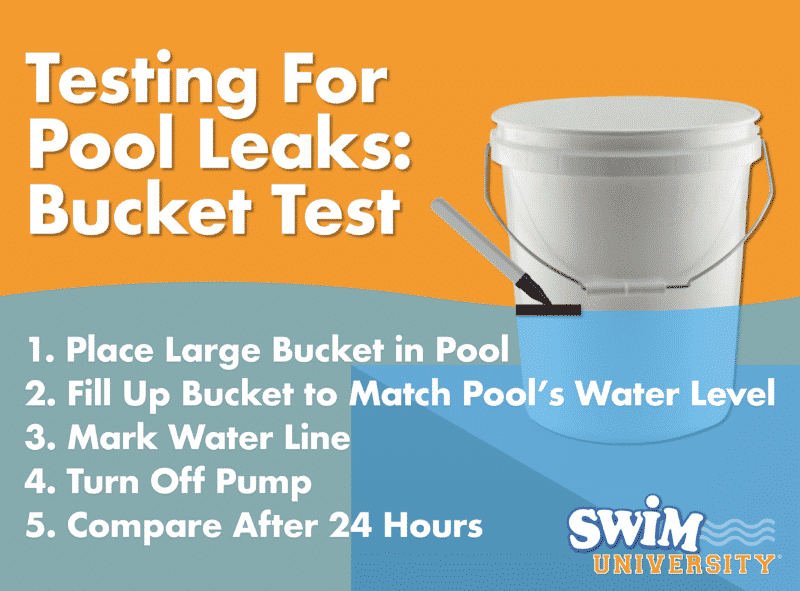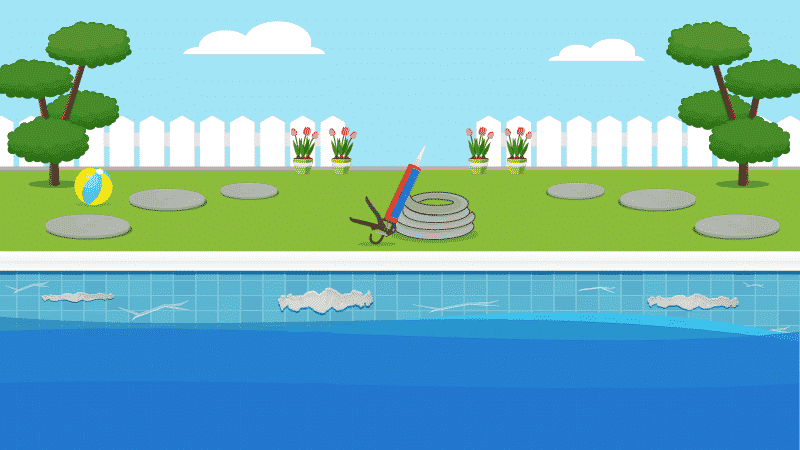Pool Leak Detection: How To Quickly Find The Leak Yourself
Pool leaks can occur anywhere in your pool. But before you start searching for a leak, you’ll need to rule out a few issues like evaporation or a crack in the filter system plumbing.
Here’s a quick guide on how to find a pool leak and how to fix it yourself. You can watch the quick video below. Or keep reading for the complete pool leak detection tutorial.
Stop wasting time and money with confusing water chemistry and maintenance. Our effortless system guarantees to keep your pool balanced, sanitized, and crystal clear all year. Works for all pools including saltwater.
How Can You Tell Where Your Pool is Leaking?
Before you run any tests inside your pool, you’ll need to make sure the leak isn’t happening somewhere inside your plumbing or pool equipment. Start by checking your entire filter system area. That includes your pool pump, filter, heater, chlorinator, and any O-ring or connections where you might be losing water. Luckily, these leaks are easy to access.
However, there’s a chance there could be a leak in a part of your plumbing you can’t see. And if you have an inground swimming pool, leaks can happen in cracked piping underground. Regardless, even if you’re not sure if you have a plumbing leak, you’ll first need to test your pool to make sure that you’re not losing water to evaporation.
Does Your Pool Have a Leak or is it Evaporation?
The first step to pool leak detection is to determine if you’re losing water to evaporation. Then, you’ll narrow down the source of the leak. You can do this with the Bucket Test or the Ink Test.
Pool Leak Detection: Bucket Test
This DIY method is easy to do and you likely already have all the supplies you need:
- 5-gallon plastic bucket
- Waterproof marker or duct tape
- Place and Fill the Bucket. Put your empty 5-gallon bucket in the water on the second step of your pool. Fill the bucket with water to match the pool’s water level. Use the marker or duct tape to mark this level inside the bucket.
- Turn Off the Pump. Turn off the recirculating pump as well as any other auto-refill device you may have.
- Compare Water Levels. Wait 24 hours and compare the pool water level to the level of water in the bucket. If both the pool and the bucket water have gone down but remain even, your pool is losing water due to evaporation. But if the swimming pool level is now lower than the level in the bucket, you likely have a leak.
- Repeat with Pump On. To narrow down the possible source of the leak, repeat the test for another 24-hour period, this time with the pump on.
- Compare New Results. If the water loss in the pool is greater with water circulating under pressure, the leak is most likely somewhere in your pool’s filter system or plumbing.

Pool Leak Detection: Dye Test
This method will help you find the exact location of the leak, but it’s a little more involved. You’ll need to purchase a leak finder dye to add directly to your pool water. It’s also handy to have some waterproof tape on hand for marking potential leaky spots in your pool.
- Check the Ground and Walls Around the Pool for Wetness. If the ground is wet where it shouldn’t be, your pool is likely leaking somewhere near that area and seeping somewhere in the ground. Keep narrowing it down as much as possible before using the leak finder dye.
- Turn Off the Pump and Water Features. You’ll need the water to be as still as possible before using the dye to help find the location of the leak. This will also help you detect leaks in or near the skimmer.
- Use the Pool Leak Detection Dye to Pinpoint the Leak. Go to the edge of the swimming pool in the area where you think the leak might be. Without touching the water, squirt the dye in the water close to the surface and the wall. If the leak is near, you will see the dye move towards the exaction location of the leak like a current.
- Mark the Spot for Patching. Use waterproof tape to mark the spot where you spotted the leak detection dye moving towards. This is to help you remember where you need to patch the leak.
If you suspect your leak is at the bottom of your pool, you’ll need a pair of goggles and swim to the bottom to perform the leak finder test. But you’ll need to be as still as possible when you run the test so the dye doesn’t go everywhere.
This pre-filled dye tester helps you find the precise location of structural pool leaks. Simply squirt the syringe into the water close to the potential problem area and the dye will flow towards the source of a leak.
If you have a concrete pool or gunite pool and it’s developed cracks, especially where the plastic skimmer meets the pool wall, you’ll need some plaster repair. Check out our complete step-by-step guide on How To Repair Plaster in a Pool. But if your pool has a vinyl liner, you can repair the patch yourself.
How To Fix a Leak in Your Pool’s Vinyl Liner
Leak repair is fairly straightforward in a vinyl liner pool. And a well-placed, quality pool patch can last for years. But no matter what method you use to repair your pool’s liner, patches are temporary. And the bigger your tear, the more likely it will snag or peel off over time.
So before you do any repair, decide if your liner is worth trying to patch or if it’s time to replace it altogether. The older the liner, the thinner it’s become and the more prone it is to spring leaks in the future.
And keep in mind that any area close to the stairs or near your pool’s fittings is being pulled by the weight of your pool water. They’re under more duress than other areas of your pool, so patches there may be less likely to hold up in the long run.
If you do want to repair the leak, there are three methods to choose from and all of them can be used underwater or dry. Do not drain your pool to fix a leak. You shouldn’t need to drain any of your water to apply a patch to a leak. Draining out too much water in an above ground pool can cause the walls to collapse. And emptying out any pool with a vinyl liner will dry it out, making the liner brittle. So plan to patch the liner underwater, unless the leak happens to be dry and above the waterline.
1. Waterproof Tape
Similar to duct tape, this tape is clear, waterproof, and resistant to UV rays. You can overlap this tape if you need to patch large sections. It’s the lowest cost option and the easiest to re-do if you make a mistake. But it’s best for smaller leak repair as it tends to peel over time.
2. Peel-and-Stick Patches
These patches are made of real vinyl and designed specifically for pools. Some patches are pre-cut into round shapes, making them less likely to peel around the edges. They’re also inexpensive and easy to use: simply remove the backing and press of the leak. But they’re also best used on smaller tears or punctures.
3. Vinyl Patch Kit
If you have a larger hole to repair or you want a longer-term solution, use a vinyl patch kit. These kits come with large chunks of blue or clear liner and special underwater vinyl adhesive. These are more complicated to use but they’ll last longer than waterproof tape or a peel-and-stick patch.
If you need more help patching a vinyl liner underwater, check out our guide on How to Patch a Pool Liner.
When To Ask a Professional to Test and Repair a Pool Leak
Pool leak detection services cost several hundred dollars. And while some pool companies might include minor patch jobs in the price, it’s worth it for any pool owner to try some of these methods before paying for a professional to come in.
But if you’re a homeowner with an inground pool and you suspect the leak is underground in your plumbing, you’ll need to call in a pool professional to pressure test the lines for possible cracks.
Remember, if swimming pool leak detection—or any other pool repair—becomes too difficult, or you’re not sure you’re getting the right results, it’s worth consulting a professional.
3 Ways We Can Help With Your Pool
- Pool Care Cheat Sheets (Free): Easy-to-use downloadable guides to help you keep track of taking care of your pool this year.
- The Pool Care Handbook: An illustrated guide to DIY pool care, including water chemistry, maintenance, troubleshooting, and more.
- The Pool Care Video Course: You’ll get 30+ step-by-step videos and a downloadable guide with everything you need to know about pool maintenance.













